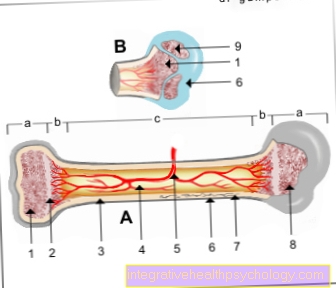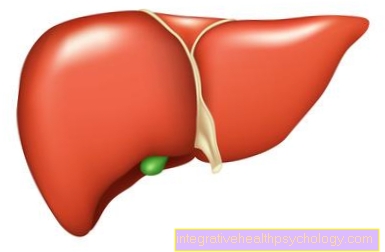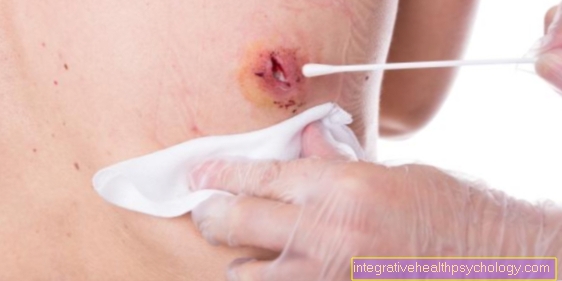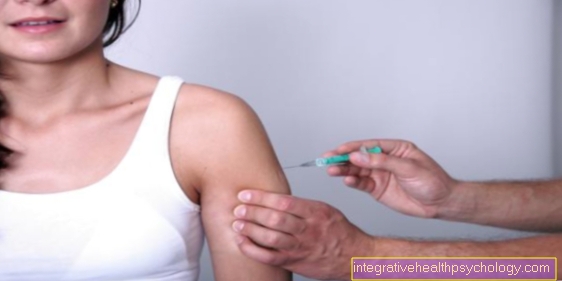Hereditary angioedema
Definition - what is hereditary angioedema?
Angioedema is a swelling of the skin and / or mucous membrane that can occur acutely and in particular in the face and respiratory tract. It can last for several days. A distinction is made between a hereditary and a non-hereditary form. Hereditary means something like hereditary, inheritable or innate. Hereditary angioedema is therefore a disease caused by a genetic defect that can be passed on from one generation to the next. The inheritance is autosomal dominant, which means that the disease is transmitted regardless of gender as soon as one of the two parents is affected by it. In around 25% of cases, however, the disease does not occur through heredity, but rather as a spontaneous mutation. This means that there is a spontaneous gene change that then causes this disease. Hereditary angioedema can be life-threatening if there is a sudden severe swelling in the airways. The incidence of the disease is around 1: 50,000, although in reality a higher incidence is assumed.

Causes of Hereditary Angioedema
The cause of hereditary angioedema is a genetic defect. This defect affects a gene that codes for a specific enzyme, which means that it is responsible for producing this enzyme. This enzyme is known as a C1 esterase inhibitor or C1 esterase inhibitor. The consequence of the genetic defect is either an enzyme deficiency or an existing but non-functional enzyme. The factors that can trigger an acute disease attack are still not adequately clarified. The fact is that the enzyme C1 esterhase inhibitor plays an important role in the complement system. This is part of the body's immune system. A deficiency in this C1 esterase inhibitor leads to a kind of hypersensitivity in this part of the immune system. This triggers a cascade, at the end of which is the tissue hormone bradykinin. This hormone increases the permeability of blood vessels (vascular permeability). This in turn leads to more liquid escaping from the vessels into the surrounding tissue. This leads to the typical swellings in the skin and mucous membrane area.
Concomitant symptoms
The typical symptoms of hereditary angioedema are recurrent swellings of the skin (especially on the face) and / or the mucous membrane in the gastrointestinal tract or in the area of the airways. Possible signs of an approaching attack (prodromi) can be symptoms such as tiredness, fatigue, an increased feeling of thirst, aggression and a depressed mood. This then leads to swelling of the skin, which is characterized by the fact that it is not red, but rather skin-colored and usually plump. They occur especially in the face area, but also on the hands, feet and genital area. The swelling is very rarely accompanied by itching, but there is often an accompanying feeling of tension. The swelling can be painful. They can regress after a few hours, but can persist for up to seven days. On average, the swelling lasts for one to three days.
Do you have genital swelling? Read more about it here: Testicular swelling or Swelling in the vaginal entrance.
Some patients may experience swelling in the airway area. Such a swelling is potentially life-threatening, since the airways can swell up to such an extent that suffocation occurs without immediate intensive medical measures with airway protection. The most common area affected by such swelling in the airway is the larynx. One then speaks of a so-called laryngeal edema. In addition to the episodic swellings that are typical of the disease, numerous patients experience accompanying symptoms in the area of the gastrointestinal tract. The most common symptoms are stomach cramps and nausea. Vomiting and severe diarrhea can also occur. The gastrointestinal complaints, like the swelling, can last for several days. In some patients, the gastrointestinal complaints occur in isolation, i.e. without the skin swelling. This can make the diagnosis much more difficult. In some patients, gastrointestinal symptoms precede skin symptoms by years. The severe, colicky gastrointestinal complaints that occur without accompanying skin symptoms are often misleading. It can come to the point that affected patients are operated on due to severe abdominal pain (acute abdomen), because there is a suspicion of surgical disease patterns, such as acute appendicitis (appendicitis).
Hereditary angioedema disease progression
Hereditary angioedema most often manifests itself by the age of 10. An initial manifestation that occurs later is rather rare. As the disease progresses, there are recurrent attacks with swelling or gastrointestinal complaints. Some patients only experience skin swelling, others only gastrointestinal symptoms. The frequency of attacks varies greatly. Some patients experience symptoms every few days, others much less often. The laboratory values are not a measure of the intensity or frequency of the complaints. On average, women are more affected than men. Symptoms can also increase during pregnancy. Hereditary angioedema is a disease that is treatable but not curable.
Most attacks in hereditary angioedema occur without an apparent trigger. In some cases, however, dental interventions or interventions in the throat and airways, for example removal of the tonsils (tonsillectomy) or intubation (insertion of a tube into the airways for ventilation, for example as part of a planned operation), can be named as the trigger. Some patients also cite flu infections or psychological stress as possible triggers. There are also certain drugs that can significantly increase the likelihood of attacks. These include, in particular, drugs against high blood pressure or heart failure, in particular ACE inhibitors such as ramipril or enalapril, or less commonly angiotensin receptor antagonists such as candesartan or valsartan. In women, the use of contraceptives that contain estrogen can also trigger attacks.
Diagnosis of hereditary angioedema
Unfortunately, hereditary angioedema is a disease that is often only correctly diagnosed after a long period of illness. First of all, the anamnesis is important. If patients report sudden, recurring swelling of the skin or mucous membranes, the diagnosis is not too far off and further diagnostics can be carried out. However, there are also patients with hereditary angioedema who do not suffer from the typical swelling of the mucous membranes, but, for example, from recurring gastrointestinal complaints. In these patients, the atypical symptoms can make diagnosis much more difficult. In addition to the personal anamnesis, the family anamnesis also plays an important role in the diagnosis. It is important to find out whether the family has had similar symptoms.
In order to ultimately secure the diagnosis, however, various blood values must be determined. Among other things, the concentration and activity of the enzyme C1 esterase inhibitor. These are reduced in hereditary angioedema. The concentration of the complement factor C4 also plays a decisive role in diagnostics. Factor C4 is present in lower concentrations in sick patients than in healthy patients. In rather rare cases, a genetic test is necessary to confirm the diagnosis. In children of sick families, the above values should be determined at an early stage in order to confirm the diagnosis. Under certain circumstances, this can be life-saving.
How does hereditary angioedema differ from "normal" angioedema?
Angioedema is a symptom that occurs in the context of two different diseases. The strict differentiation between the two clinical pictures is important because the development and treatment of the diseases differ significantly from one another.
While hereditary angioedema is a hereditary disease and is caused by a lack of inactivation or excessive activation of the complement system, "normal" angioedema, also known as Quincke's edema, often occurs in the context of urticaria. Here, the angioedema can accompany the urticaria but also occur separately and as the only symptom. The angioedema that occurs in the context of urticaria is histamine-mediated. So they occur as part of an allergic reaction. The body reacts allergic and there is an increased release of histamine. Histamine leads to an increased blood vessel permeability (vascular permeability) and there is an increased outflow of fluid from the vessels into the tissue. Both forms of angioedema have in common that there is an increased leakage of vascular fluid into the tissue. This results in swelling of the affected areas. The triggering tissue hormone differs, however: histamine in "normal" angioedema versus bradykinin in hereditary angioedema.
While hereditary angioedema often leads to symptoms for the first time before the age of 20, “normal” angioedema often only manifests itself in adulthood. In "normal" angioedema, the histamine effect not only causes swelling but also redness and itching in the area of the swollen areas. In hereditary angioedema, on the other hand, the swelling is not red but skin-colored and itching is rare.
"Normal" angioedema can be caused by infections or drugs. In many cases, however, the cause remains unexplained. In most cases of "normal" angioedema there are no pathological laboratory values, while in the hereditary form certain values are conspicuous. While hereditary angioedema occurs in the face, but often also in the gastrointestinal tract, “normal” angioedema usually only affects the face area (especially the mouth and eye area).
With both forms of the disease, there is a risk of the airways becoming blocked, known as laryngeal edema. This is acutely life-threatening and requires immediate emergency therapy. The type of emergency therapy - as well as standard therapy - differs between the two forms. "Normal" angioedema responds well to therapy with antihistamines or steroids / corticoids such as prednisolone, as well as adrenaline as part of emergency therapy. In the case of hereditary angioedema, on the other hand, these drugs are ineffective; special drugs must be used.
Treatment of hereditary angioedema
It is essential to keep in mind that hereditary angioedema is a potentially life-threatening condition, since airway constriction without adequate measures can lead to rapid death from suffocation. It is therefore crucial first of all to provide the patient with an emergency ID card, which should be carried with you at all times and everywhere. In addition, patients and relatives must be informed in detail about the possible symptoms and the measures to be taken in an acute case. In most cases, an initial treatment at a specialized treatment center is recommended.
Treatment of the swelling in acute cases is not always necessary.Slight swellings in the area of the hands and feet do not necessarily require treatment, provided they do not bother the person concerned. The gastrointestinal attacks do not necessarily have to be treated either. In the case of moderate attacks, oral intake of an antispasmodic drug such as Buscopan ® may be sufficient.
In some cases, however, the colicky symptoms are so painful that specific treatment is necessary. In acute cases, a so-called C1-INH concentrate is administered. These are inhibitors of a certain factor (C1) of the immune system, which can reduce swelling. The concentrate must be administered via a venous access, which can also be carried out independently through training. Alternatively, Icatiband is available. It is a so-called bradykinin antagonist that can be injected under the skin and inhibits the vasodilating hormone bradykinin.
Patients with swelling of the mouth, throat, or larynx are considered to be an emergency and must be admitted to hospital immediately. Intubation may be necessary here to secure the airways.
If more than 12 attacks occur per year despite adequate therapy, prophylactic (preventive) measures should be considered. Androgens such as danazol, oxandrolone and stanazolol can be used for this, but because of their numerous side effects, they are not approved for the treatment of hereditary angioedema in Germany. Another drug for long-term prophylaxis is tranexamic acid, which is antifibrinolytic, i.e. it counteracts the dissolution of blood clots. A possible side effect is therefore the formation of blood clots (thrombosis). Long-term treatment with C1-INH concentrate is also a possible therapeutic approach.
Prognosis of Hereditary Angioedema
Nowadays, the prognosis for patients with hereditary angioedema is significantly more favorable than it used to be due to the significantly improved therapeutic measures. Nevertheless, it still happens that patients die of acute laryngeal edema because they are not given adequate therapy quickly enough. The diagnosis is therefore extremely important in order to be able to train patients and relatives accordingly and to be able to adequately prepare for emergency situations. Every patient with hereditary angioedema should have an emergency ID card and always have it with them.





























